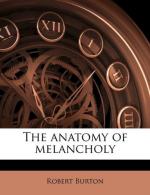“It will be no detraction from the powers of Milton’s original genius and invention, to remark, that he seems to have borrowed the subject of L’ Allegro and Il Penseroso, together with some particular thoughts, expressions, and rhymes, more especially the idea of a contrast between these two dispositions, from a forgotten poem prefixed to the first edition of BURTON’S ANATOMY OF MELANCHOLY, entitled, ’The Author’s Abstract of Melancholy; or, A Dialogue between Pleasure and Pain.’ Here pain is melancholy. It was written, as I conjecture, about the year 1600. I will make no apology for abstracting and citing as much of this poem as will be sufficient to prove, to a discerning reader, how far it had taken possession of Milton’s mind. The measure will appear to be the same; and that our author was at least an attentive reader of Burton’s book, may be already concluded from the traces of resemblance which I have incidentally noticed in passing through the L’ Allegro and Il Penseroso.”—After extracting the lines, Mr. Warton adds, “as to the very elaborate work to which these visionary verses are no unsuitable introduction, the writer’s variety of learning, his quotations from scarce and curious books, his pedantry sparkling with rude wit and shapeless elegance, miscellaneous matter, intermixture of agreeable tales and illustrations, and, perhaps, above all, the singularities of his feelings, clothed in an uncommon quaintness of style, have contributed to render it, even to modern readers, a valuable repository of amusement and information.”—Warton’s Milton, 2d edit. p. 94.
“THE ANATOMY OF MELANCHOLY is a book which has been universally read and admired. This work is, for the most part, what the author himself styles it, ‘a cento;’ but it is a very ingenious one. His quotations, which abound in every page, are pertinent; but if he had made more use of his invention and less of his commonplace-book, his work would perhaps have been more valuable than it is. He is generally free from the affected language and ridiculous metaphors which disgrace most of the books of his time.”—Granger’s Biographical History.
“BURTON’S ANATOMY OF MELANCHOLY, a book once the favourite of the learned and the witty, and a source of surreptitious learning, though written on a regular plan, consists chiefly of quotations: the author has honestly termed it a cento. He collects, under every division, the opinions of a multitude of writers, without regard to chronological order, and has too often the modesty to decline the interposition of his own sentiments. Indeed the bulk of his materials generally overwhelms him. In the course of his folio he has contrived to treat a great variety of topics, that seem very loosely connected with the general subject; and, like Bayle, when he starts a favourite train of quotations, he does not scruple to let the digression outrun the principal question. Thus, from the doctrines of religion to military discipline, from inland navigation to the morality of dancing-schools, every thing is discussed and determined.”—Ferriar’s Illustrations of Sterne, p. 58.




